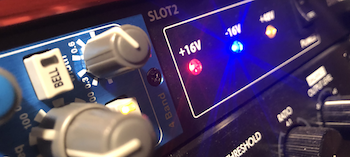July 30, 2020 : I have been busy upgrading my small home-studio and testing guitar and IR recording (Impulse Responses) with a new -and hopefully- improved setup.
I have been aiming at improving the quality, the diversity and usability of my IRs:
- Tried to lower the room reverberation, using a few acoustic devices and treatments, so that I would be able to use more distant mic positions
- Upgraded one of the microphone preamps tubes to a 12AX7 Genalex Gold Lion and the other ones to JJ Selected Gold tubes.
- Started using the power section of a guitar amp with KT-88 tubes (Ruby) for IRs, I’ll probably continue using 6L6’s and KT88’s in the future
- Upgraded the microphone signal path
- Tested various amp settings and microphone positions with actual saturated guitar recordings and impulse recordings with KT88’s
- Adjusted the recording levels of the different elements in the recording path
- Tried to find better sweet spots for microphones/cabs/speakers (actual recording vs IR recording, for speaker / microphone distance calibration)
- Started experimenting on using Fredman technique with SM57 mics
New published collections will potentially include :
- Mic positions farther away from the speaker, essentially for ribbon mics, in order to counter balance their huge proximity effect and the huge level of bass delivered by metal cabs (such as the German 112 or the Calif Recto 212). These recording positions are more subject to room reverberation/reflections but can provide a nice « room » feel and tone balance for standalone guitar practice … and more.
- Multiple microphone preamps : I am still using tube preamps but I may also include solid-state preamp based IRs.
- Various microphone preamp settings and EQ usage to provide alternate IR takes : less scooped mids (with multiple settings that are named -M1 to -M7) , boosted clarity with -BRIGHT versions for better attack/definition, or solid-state preamp saturation with -SAT and -SAT2 versions (adding distorsion in high and mid frequencies). Some IRs will be based on a combination of these settings. IR file names not including -Mx, -BRIGHT or -SAT are the raw IRs (only using an HPF).
New collections published from this summer will be part of Overdriven.fr « Gen2 » IRs 🙂
I took some time to create a small utility to process the output of the Apple Impulse Response Utility (which is AIFF-C format, 88200 samples per second in 32 bits floating point) and automatically crop/align the files more precisely, with 4410 samples (which gives 50 milliseconds). The files are then later converted to WAV 32 bits floating point at 44100 Hz sample rate for publication. This automated crop/conversion tool should allow me to publish new collections faster.
I also added a few microphones to my small collection, and I decided to keep their brand and types secret for some time; they will be described with a code name (let’s focus on the tone and less on the mics brand 🙂 ).
Here are the newcomers :
Ribbon microphones :
- RBN-CN-1 : Ribbon China 1
- RBN-CN-2 : Ribbon China 2
- RBN-DE-2 : Ribbon Germany 2
Condenser microphones :
- CND-AT-1 : Condenser Austria 1
- CND-AT-1 : Condenser Austria 2
Dynamic microphones :
- DYN-GB-1 : dynamic mic GB 1
- DYN-AT-1 : dynamic mic Austria 1
- DYN-AT-2 : dynamic mic Austria 2
- DYN-US-6 : dynamic mic USA 6
- DYN-CN-7 : dynamic mic China 7
Using and checking the IRs I have published so far, I could realize that the mids scoop was coming from the amp(s) used for capture for one part, but was coming as well from the CAB themselves, especially from the German 112 ported one, with its strong bass level. So I used some of my summer time to finish a custom made 112 CAB (let’s name it “Overdriven-112” ) and I’ll leverage it to provide additional tone options, with slightly less scooped mids as it produces less bass than its German 112 cousin.
Hope you will enjoy the 2nd Gen IRs 🙂 and do not hesitate to post comments, feedback or demos.
David.

2025-01-08 at 10:47
Very detailed and professional
2025-01-08 at 20:28
Thank you Heaven !
David